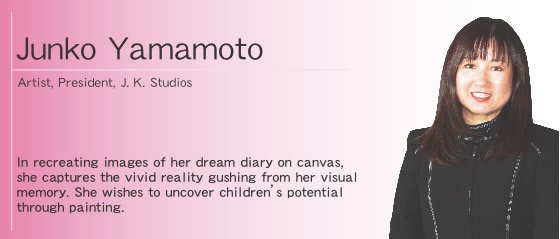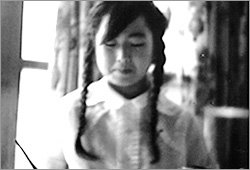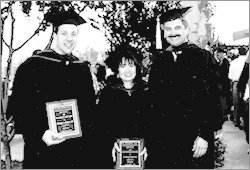YuYu interview Junko Yamamoto
 |
| I portray myself my inner world. I want to create works of art that speak of my true world, so I have no choice but to create works that have something to do with myself. I want to reveal the essence of the world that I know, so I try to detach myself as much as possible from borrowed beliefs or reasons when I am painting. This makes me particular about how to depict concrete portions, such as the quality of lines, colors, and composition, rather than the content of an image. Also, I try to conjure up images from my subconscious mind. This is because of my desire to portray the scenes more correctly that I have so deep inside me that I am usually unaware of. So, while I am painting I don't think about what my subject means to me. I don't want to create objects art or artifacts that have value as objects. I want to create works while facing a world unknown to me. I want to have an adventure to discover a world that is beyond my understanding. Most of the time, painting is a battle for me. After reaching a certain point, though, my work and I will have a sort of dialogue, which brings me to a new dimension. If I can evoke a similar experience in those who enjoy my works, that's a delight for me as an artist. (Junko Yamamoto) —— What are the characteristics of your art? 
In a painting class (at age ten)
When I try to depict a dream in a tangible form, I don't limit my creation to a piece of canvas. Rather, I try to express it on a series of canvases, as if recording visual images. Even if I am trying to convey even one minute of a dream, I could paint an endless number of pictures. In this way, as I try to look at the dream from different angles, I create hundreds of paintings. When I wake up in the morning, I forget more than half of my dreams from the night before and by the afternoon, only the most impressive parts remain in my mind. In fact, I can only remember a portion of my dreams. Thus, the more details of the dreams I describe, the more the imaginary side if things is emphasized. When I create a piece I try to finish it quickly in a week or so. If I had enough time to paint, I would increase my desire to paint from a different direction. If that's the case, I would complete my creation by painting the canvas all white. That's what I feel. When I wake up from a dream, I return to reality. It's like a movie ending with a white screen and the theater closing its curtains. In other words, I think the best way would be to take many years to finish a painting, revising it again and again, and finally painting the canvas in all white. After all, painting with a simple mind is the easiest way and allows me to be like a child again, enjoying my work. —— Do you make a detailed plan for your work or a new project beforehand? No. I am always making sketches or brainstorming. It doesn't matter if it's for an exhibition or not. Basically I am always working. One of the happiest times fro me is when I am thinking about my works or creating them. If I had noting but free time, it would be my ultimate pleasure to spend it doing something connected to art. —— Do you have a sense of accomplishment, such as “I have achieved all this”? I don't think that way, either. The world of art is very profound and yet scary. It is still an unknown world that I will not completely understand in my life. If I don't start with an individual object, what do I start with? If I keep creating works while feeling like this, I would think the object would disappear as soon as I get to know it. I would strongly like to reduce the number of exhibitions I do at this point and concentrate on my creations. I don't believe a painter should focus on participating in exhibitions. A painter's job is to create works of art. An exhibition is just a place for an artist to present his or her work after it is completed. I like taking time to think about each work of mine, independently of the exhibitions. I've been an artist for twenty years and now I feel like giving my soul and body some tranquility. I wonder if I could transform myself into serenity itself. Feeling that way, I contribute my precious spare time to children, believing that the new generation of art will be born out these activities. 
Lino print: “We Cannot Go Back to the Past,”1987
My father was a fashion designer for men's apparel. So, since childhood I have always had art around me. He ran a number of boutiques, so fashion shows and exhibits were like my playgrounds. The other day, while organizing my photo albums, I found a picture in which I was painting flowers on a canvas (see the previous page). I was about ten. Until I found that photo, I had totally forgotten that I had taken that painting class near my home. I learned that when I was little I designed my own clothes and I continued designing kimonos (painting patterns) until I turned twenty. I guess I have liked painting since I was young, but I didn't try to become a painter then. In college, I studied to be a nutritionist. Then one day, I was given an opportunity to learn about overseas cultures when I was selected as one of the delegates representing Japanese universities and colleges. As part of that program I traveled to nine European countries in two months. In Italy, I visited the Scrovegni Chapel in Padua where I saw Giottoユs frescoes*. The moment I saw them they made a strong impression on me. I don't know how to describe it. It was so different than when I saw them in my art books. It was as if I could hear the voices from all the paintings there. * Fresco: a painting on a wall made by brushing water-based pigments onto fresh, moist plaster, which is applied only when needed. It is difficult to redo a fresco, so producing it requires mastery of painting. 
At the presentation ceremony of the Miramar College Graduation Alumni Award, 1996
In 1971, upon being married I started my life in San Diego. My husband liked America, and he gained permanent residency here when he was young. He had been living and working in Arizona before we met. There actually is an interesting story about our marriage. In 1970, I went to the Osaka World Expo with my father and a friend of mine and we visited a dear old friend of my father's who lived in Osaka. He was the father of my future husband. I met his parents for the first time, but somehow, they told me they wished I would marry their son. They asked me to meet their son when he returned to Japan. I went back to our home in Yokohama and told my mother about this. She strongly opposed it, even though she didn't know anything about Arizona. I had a fianc at the time, so I intended to turn down the request. Then, on the day he arrived we met for the first time at Haneda Airport, but when I tried to talk to him, his father said, We don't have time right now. If you have something important to talk about, please visit us in Osaka, and gave me a flight ticket to Osaka. I was very surprised, but I couldn't do anything but go to their place in Osaka. While I hesitated to tell them about my intention, the next day came. His father told me, Let's go out, and the place he took me to was a wedding hall! He said our wedding would take place in a week. His son never proposed to me! (Laughter) While I had no idea what was going on, I returned to Yokohama and told my parents about my wedding. That astonished my mother, but my father looked happy because he had known the groom for a long time. Actually, I don't know what made me decide to marry him, but while talking to him, I guess, I may have come to wish to help him since he was all alone working hard in America. So, we got married a week later as planned. In the next week we had two separate wedding receptions in Yokohama. I was still in college, so I stayed and came to the US the next year after graduation. Meanwhile, my husband had moved from Arizona to San Diego. That's why I came here. 
At Junko Yamamoto Thesis Exhibition, 1990
Yes. I decided a few years after coming to the US. Soon after, we had our first and second sons. I was busy raising our children and so I didn't have time to go to school to learn English. I came to hate spending my days without being able to communicate in English. For that reason, I went back to Japan for a while. My mother, of course, rebuked me, "What are you doing? You have your children. Go home to them." Upon my return to San Diego, I discussed going to back college and studying with my husband. Even though I felt guilty about putting more parenting and housework responsibility on him, I decided had to study because I realized that it was important for me to be able to speak English while educating our children and that this was the only chance for me. Encouraged by the phrase, Children grow while watching their parents, I believed that our children would understand, although I had less time with them. At first I majored in business, but later I changed my major to fine arts and became an artist. —— Did you have any hardships as a student? I have been competitive since I was a child, so in school I wasn't satisfied with anything other than an "A". I was the same way when I came here, but it was only natural that good grades didn't come easily, because I didn't understand English at all. One of the subjects that I took when I started attending college here was American History. In that class we had exams every other week, and I got a "C" on one of them. I was shocked, so I told the teacher that I wanted to drop out of the class, but he told me, "A" "C" in this class is equivalent to an "A" in some other classes, so you should have confidence. and he encouraged me to do better the next time. Still, I had the same grade on the next exam. I soon realized that I was not good at "True or False" questions. To be precise, I couldn't understand the meaning of the questions because I didn't understand English well enough. Every time we had an exam, I just relied on guesswork to answer the questions. (Laughter) So, I told the teacher again that I wanted to drop out of the class. Then he took a look at my notes and told me to come by his office. From then on, I went to his office after every class session and got training in how to answer "True or False" questions. That helped me improve my performance on exams and I finally earned an "A". The teacher said, I saw the way you took your notes and was convinced that you could make it. I believe this experience gave me confidence in myself. After college, I transferred to San Diego State University and graduated and eventually got my MA from there. One of my dreams when I was in Japan was to receive my Ph.D., but I gave it up, partly because my parents were against it. So I was greatly delighted when one of my dreams in America, which was to receive my M.A., came true after ten years of study. 
In an art class at Kennedy Children’s Center (National City), held 4 - 5 times a year
You may have heard that the left brain is also called the language brainモ whereas the right brain is called the image brain. By training the right brain that has a memory function to store visual images, you can enhance your imagination, increase your memory, or make yourself more flexible in your way of thinking. The well-trained image brainモ fosters children's sensitivity, helps their intellectual activities, and broadens their world infinitely. Observing the children who come to my painting school, J. K. Studios, I've noticed that they gradually show their unique personalities, rather than picking up advanced painting techniques quickly or developing their skills rapidly. I am amazed how much children change. Obviously, they become more confident and animated, their eyes sparkling. Children have treasures their potential and unique worlds still unknown to them, which we look for and discover together. In my painting school, I focus on to discover and developモ rather than to teach. In any case, I hope to bring out the childrenユs power, and uncover their talents rather than keeping it buried forever. —— What is your goal in the future? to keep providing something literally and artistically advanced. I hope that children expose themselves to paintings at an early age, and develop an affection and adoration for beauty. This year marks the seventh year of J. K. Studios and every summer, we hold an exhibition featuring our students' paintings, where I gain valuable experience and insight through looking at today's children"s lives. Last year, we exhibited the works of forty students. I was charmed by their use of vivid colors or their clearness of expression. Rather than feeling nostalgic for my own childhood, I enjoy their works, as if I had become a child again. As a grown-up, I've forgotten some of the things from my childhood. It is always the greatest pleasure for me to enjoy these paintings from a childユs point of view. I believe I've come this far because I was a Japanese who didn't speak English well. If I had spoken English well from the beginning, I might have had a different career or might not have drawn attention as an artist. Currently I am busy teaching at J. K. Studios, so I am taking a break from my Dream Diary. I hope I'll start painting again someday. I look forward to spending busy days facing the canvas. (05-01-2004 issue) |

